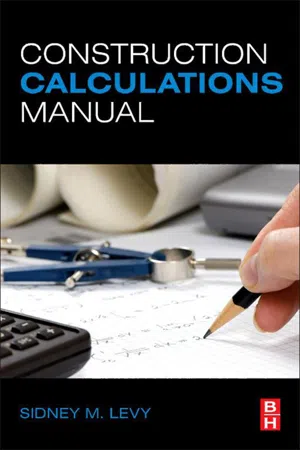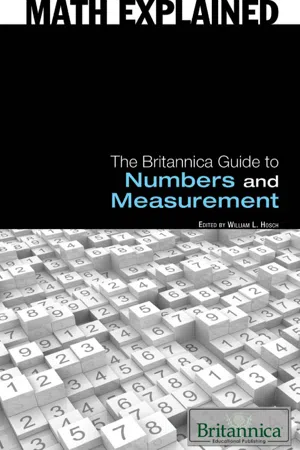Mathematics
Metric and Imperial Units
Metric and Imperial units are systems of measurement used to quantify length, weight, volume, and other quantities. The metric system is based on units such as meters, grams, and liters, while the Imperial system uses units like feet, pounds, and gallons. In mathematics, understanding and converting between these two systems is important for solving problems involving measurement.
Written by Perlego with AI-assistance
Related key terms
5 Key excerpts on "Metric and Imperial Units"
- eBook - ePub
- Mark Zegarelli(Author)
- 2016(Publication Date)
- For Dummies(Publisher)
10 ) can be difficult to work with.The metric system was invented to simplify the application of math to measurement. Metric units are based on the number 10, which makes them much easier to work with. Parts of units are expressed as decimals, which (as Chapter 11 shows you) are much friendlier than fractions.Yet despite these advantages, the metric system has been slow to catch on in the U.S. Many Americans feel comfortable with English units and are reluctant to part with them. For example, if I ask you to carry a 20-lb. bag for one-fourth of a mile, you know what to expect. However, if I ask you to carry a bag weighing 10 kilograms half a kilometer, you may not be sure.In this section, I show you the basic units of measurement for both the English and metric systems.If you want an example of the importance of converting carefully, you may want to look to NASA — they kind of lost a Mars orbiter in the late 1990s because an engineering team used English units and NASA used metric to navigate!Looking at the English system
The English system of measurement is most commonly used in the United States (but, ironically, not in England). Although you’re probably familiar with most of the English units of measurement, in the following list I make sure you know the most important ones. I also show you some equivalent values that can help you do conversions from one type of unit to another.- Units of distance: Distance — also called length — is measured in inches (in.), feet (ft.), yards (yd.), and miles (mi.):
- Units of fluid volume: Fluid volume (also called capacity ) is the amount of space occupied by a liquid, such as water, milk, or wine. I discuss volume when I talk about geometry in Chapter 16 . Volume is measured in fluid ounces (fl. oz.), cups (c.), pints (pt.), quarts (qt.), and gallons (gal.):
- eBook - ePub
- Christine Hopkins, Ann Pope, Sandy Pepperell(Authors)
- 2013(Publication Date)
- David Fulton Publishers(Publisher)
www.npl.co.uk ). The metre, kilogram and second are commonly known as SI units (International System of Units), recommended by the Conference Generale des Poids et Mesures in 1960. In the UK both imperial and metric measures are still used in everyday life but it is the metric system which is explicitly taught in schools.IMPERIAL UNITS
The equivalence of imperial units has a historical base so there are no easy ways of remembering them. The table below shows some relationships.length 12 inches (ins) in 1 foot (ft) 3 ft in 1 yard (yd) 1760 yds in a mile. area 144 square ins in a sq. ft 9 sq. ft in a sq. yd 640 acres in a sq. mile volume 1728 cubic ins in a cu. ft 27 cu. ft in a cu. yard capacity 5 fluid ounces in a gill 4 gills in a pint (pt) two pts in a quart eight pts in a gallon or 4 quarts in a gallon mass 16 ounces (oz) in a pound (lb) 14 lbs in a stone (st) 8 st in a hundredweight (cwt) and 20 cwt in a ton METRIC UNITS
Metric units are much easier to work with than imperial units because they are all based on powers of ten.The basic units are metre, litre and gram. The prefixes tell you the multiple of the unit you require. How many grams in a kilogram? 1000. How many metres in a kilometre? 1000.A tonne is 1000 kg. There are 100 hectares in a square kilometre. One of the great things about metric units is the relationship between volume and capacity: a volume of 1 cubic centimetre is equivalent to 1 millilitre. - eBook - ePub
- Sidney M Levy(Author)
- 2011(Publication Date)
- Butterworth-Heinemann(Publisher)
The National Institute of Standards and Technology provides official United States representation in these organizations. The CGPM, the CIPM, and the BIPM have been major factors in the continuing refinement of the metric system on a scientific basis and in the evolution of the International System of Units.Multiples and submultiples of metric units are related by powers of ten. This relationship is compatible with the decimal system of numbers, and it contributes greatly to the convenience of metric units.2.2.2 International System of Units
At the end of World War II, a number of different systems of measurement still existed throughout the world. Some of these systems were variations of the metric system, and others were based on the customary inch-pound system of the English-speaking countries. It was recognized that additional steps were needed to promote a worldwide measurement system. As a result the 9th GCPM, in 1948, asked the ICPM to conduct an international study of the measurement needs of the scientific, technical, and educational communities. Based on the findings of this study, the 10th General Conference in 1954 decided that an international system should be derived from six base units to provide for the measurement of temperature and optical radiation in addition to mechanical and electromagnetic quantities. The six base units recommended were the meter, kilogram, second, ampere, Kelvin degree (later renamed the kelvin), and the candela.In 1960, the 11th General Conference of Weights and Measures named the system based on the six base quantities of the International System of Units, abbreviated SI from the French name: Le Système International d'Unités. The SI metric system is now either obligatory or permissible throughout the world.2.2.3 Units and Standards of the Metric System
In the early metric system there were two fundamental or base units, the meter and the kilogram, for length and mass. The other units of length and mass, and all units of area, volume, and compound units such as density were derived from these two fundamental units. - eBook - ePub
Olin's Construction
Principles, Materials, and Methods
- H. Leslie Simmons(Author)
- 2011(Publication Date)
- Wiley(Publisher)
Chapter 24 The Metric System of Measurement Introduction The History of Measurement The Metric System The International System of Units SI Units for Design and Construction Conversion of Numerical Values Preferred Dimensions and Coordination Metric Conversions Applicable to This Book Additional Reading Acknowledgments and References IntroductionMetrication is a term coined in Britain to describe metric conversion, which is the process of changing from the customary to the metric system of measurement, including the planning and coordination necessary for the change.The customary system of measurement referred to here is the collection of English and other nonmetric units currently used in the United States. The customary system is also called the inch-pound (I-P) system and this abbreviation is sometimes used in this textbook. The metric system is a system originally developed in France that has been adopted by more than 90% of the nations of the world. It is based on the metre and six other standardized base units . Metric units already in general use include, but are not limited to, the second , ampere , candela, watt , volt , ohm, farad , coulomb , and lumen .Much of the material in this section is based on two current metric standards:1. IEEE/ASTM SI-10, which is a replacement for American Society for Testing and Materials (ASTM) E380-89a, “Standard for Metric Practices.”2. - eBook - ePub
- Britannica Educational Publishing, William Hosch(Authors)
- 2010(Publication Date)
- Britannica Educational Publishing(Publisher)
Throughout the 20th century, use of the metric system in various segments of commerce and industry increased spontaneously in Britain and the United States; it became almost universally employed in the scientific and medical professions. The automobile, electronics, chemical, and electric power industries have all adopted metrics at least in part, as have such fields as optometry and photography. Legislative proposals to adopt metrics generally have been made in the U.S. Congress and British Parliament. In 1968 the former passed legislation calling for a program of investigation, research, and survey to determine the impact on the United States of increasing worldwide use of the metric system. The program concluded with a report to Congress in July 1971 that stated:Parliament went further and established a long-range program of changeover.On the basis of evidence marshalled in the U.S. metric study, this report (D.V. Simone, “Metric America, A Decision whose Time has Come,” National Bureau of Standards Special Publication 345) recommends that the United States change to the International Metric System.THE INTERNATIONAL SYSTEM OF UNITSJust as the original conception of the metric system had grown out of the problems scientists encountered in dealing with the medieval system, so a new system grew out of the problems a vastly enlarged scientific community faced in the proliferation of subsystems improvised to serve particular disciplines. At the same time, it had long been known that the original 18th-century standards were not accurate to the degree demanded by 20th-century scientific operations; new definitions were required. After lengthy discussion the 11th General Conference on Weights and Measures (11th CGPM), meeting in Paris in October 1960, formulated a new International System of Units (abbreviated SI). The SI was amended by subsequent convocations of the CGPM. The following base units have been adopted and defined:Length: Metre Since 1983 the metre has been defined as the distance traveled by light in a vacuum in 1/299,792,458 second. Mass: KilogramThe standard for the unit of mass, the kilogram, is a cylinder of platinum-iridium alloy kept by the International Bureau of Weights and Measures, located in Sèvres, near Paris. A duplicate in the custody of the National Institute of Standards and Technology serves as the mass standard for the United States. (This is the only base unit still defined by an artifact.)
Index pages curate the most relevant extracts from our library of academic textbooks. They’ve been created using an in-house natural language model (NLM), each adding context and meaning to key research topics.




